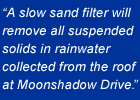
| Home |
| Introduction |
| Hypothesis |
| Methodology |
| Data & Analysis |
| |
| |
| Conclusion |
| Credits |
| Learn More |

 EWEB Lab |
 Conductivity meter |
 Pre & post filtered sample |
Data & Analysis
Part 1 - Baseline Analysis of Rainwater Samples
Six common water quality tests were performed on five water samples to provide background on water quality issues relevant for rainwater harvesting. This process aided in formulation of a study experiment and provided context for the results.

pH
pH levels in the cistern water were predictably high due to leaching within
the concrete structure. This is a standard chemical reaction with new
concrete and will require a full flush to remedy the problem. Both the
metal and shingle roof samples however were low, or acidic, in
comparison to the EWEB norms. This is expected for rainwater.
Turbidity
The asphalt shingled roof was the most turbid, as was
expected given its brownish color. This roof structure was not designed nor is it maintained for
rainwater collection and was sampled to display the difference in water
quality. Tap water collected at Moonshadow Drive tested higher than EWEB
standards with regard to turbidity. This is reasonable since the water is
bound to pick up some sediment during distribution.
Conductivity
Rainwater in its natural state, is very close to de-ionized but after passing over the zinc based anti-moss
compound found on the shingled roof structure, conductivity is much higher.
Hardness
In its natural state rainwater is very soft and this tested
true of the samples collected from the metal roof. There is
little opportunity for the water to absorb minerals running off
a smooth metal surface. After passing over the granite boulder
and then into the cistern the water hardness levels begin to
rise.
Total Suspended Solids
Given a chance to settle out, one would expect sub-surface cistern water to
have fewer suspended solids than water sampled from the inlet. In this case
however, bits of flocculant scum floating in the cistern water suggest bacterial
activity, the presence of organic food matter, and thus suspended solids.
Coliform Colony Counts
Coliform counts presented here are not scientifically accurate since the collection
containers were not sanitized prior to sampling. It is interesting to note
however that residual chlorine in the tap water prevented any coliform
growth in that sample.
Rainwater Harvesting is a Vital Signs Case Study
prepared by Angela Matt and
Joshua Cohen, Spring 2001.